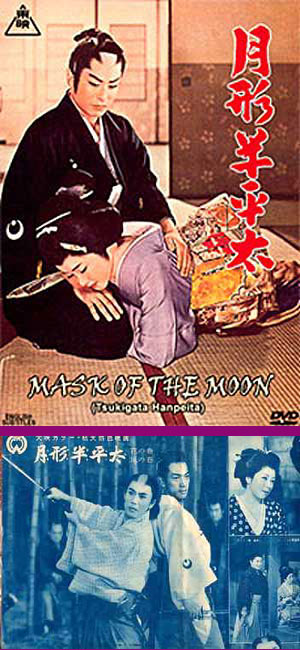It's near the end of the Tokugawa era. Choshu Clan's Lord has apparently been seeking a Choshu-Satsuma alliance against the desparate Tokugawa regime. But Choshu vassals are divided as to their opinons of this move, as not all are devoted to the idea of the Emperor's restoration.
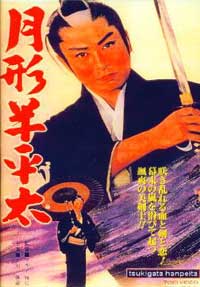 Enter Hashizo Okawa playing the titular character Hanpeita Tsukigata (Mask of the Moon, Toei, 1961). During his first fight scene against Loyalists serving the Togukawa regime, he sings a folk song while duelling. He fights the Honshu Loyalists with the back of his sword so as not to harm them. But when Okudaira (Isao Yamagata) of the severe Shinsen group joins the fray, the battle is in earnest, & death is dealt. Enter Hashizo Okawa playing the titular character Hanpeita Tsukigata (Mask of the Moon, Toei, 1961). During his first fight scene against Loyalists serving the Togukawa regime, he sings a folk song while duelling. He fights the Honshu Loyalists with the back of his sword so as not to harm them. But when Okudaira (Isao Yamagata) of the severe Shinsen group joins the fray, the battle is in earnest, & death is dealt.
Tsukigata is a member of Mimawari-gumi, a Royalist militia. Because Tsukigata has had meetings with Loyalists, his fellow members of Mimawari group call him a spy, which enrages him. He has to avoid old friends for some while, lest he attack someone for sake of his pride or honor, & so sets out for the pleasure district.
Somehachi, a nice girl, regards Tsuki as her enemy, for she wants to avenge Okudaira. Women in this film are whiney, weak, or ditzy & Somehachi ultimately no improvement. Tsukigata also has a relationship with a geisha who is uninteresting because she's so trivial a person, but the script doesn't realize this.
The point of Tsukigata's fondness for the pleasure district is to show his love of life, but because he hasn't managed to befriend women of any particular merit beyond their decorativeness, his character is cheapened, & the story recovers only when he gets away from this element of the story.
Young Hayashi had been feeling miserable that Mimawari group was killed the innocent as well as the guilty. He sets out to befriend Tsukigata, who he has noticed doesn't like killing even those who have been his enemy.
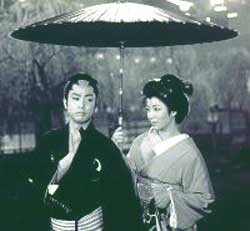 The lord of Choshu commands his formerly Royalist vassals to become Loyalists in support of the Shogun & accept the Satsuma alliance. The lord of Choshu commands his formerly Royalist vassals to become Loyalists in support of the Shogun & accept the Satsuma alliance.
Tsukigata Hanpeita has wanted hostilities between clans to stop, but he hasn't wanted to support the failing shogunate. So he is prepared to rebel against this unexpected decision, weary of mere politics that waver with the wind, when from his point of view there is such a thing as right & wrong.
Tuskigata wants to see the entire medieval class system come to an end, & would like to "plunge into a new world" where all men are equals. Believing that Lord Mori of Choshu won't support that noble goal, Tsuki decides he has no choice but to desert the clan, or so he boasts on a drunken night.
Katsura, disguised as a peasant, arrives with a gun, & informs Tsukigata that Lord Mori of Choshu really does plan to join with Satsuma to overthrow the Tokugawa regime, & Tsuki is so relieved. But for the time being, his own opinion of matters makes him look like a rebel within the clan.
After Tsukigata killed Okudaira, Shinsen-gumi men decided to help Mimawari group kill Tsukigata who they've come to regard as a spy. When Tsuki is attacked under the bridge, it is one-against-many, & he gives no quarter, sad though he may be to be reduced to a killing machine. Despite that Tsukigata is rather too fond of drunkenness & geishas, he's an invincible swordsman even staggering, & a good thing too.
Daisuke Ito scripts are always action-packed, & Mask of the Moon has plenty of swordplay. Tsukigata is tricked into a meeting by night, in an out of the way place, where he's ambushed. Shinsen-gumi men attack & it's all-out bloodshed.
Hayasa found out about the ambush & rushed off hoping to assist Tsukigata, but Mimawari-gumi men waylay Hayasa. The two separate but simultaneous one-against-all fights provide the best swordplay choreography of the film. Tsukigata, severely wounded, fights on & on, with a two-sword style. He will be victorious against Shinsen-gumi, but will himself be unable to recover from such severe injuries.
Tsuki's end is moving, kabukiesque in expression, extreme, one of the hammiest but coolest death scenes ever. The film as a whole is in a minor note, but with the final double-action scene & the amazing sentiment of Tsukigawa's death scene, the mastery of veteran director Makino Masahiro comes to the fore, as does screenwriter Daisuke Ito's storytelling prowess. The result is a commercial product that doesn't disappoint even if it's no great work of art.
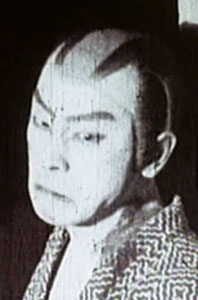 The character of Tsukigata Henpeita is fictional, having originated in a 1919 kabuki stage play, when the unusual hairline for the character was developed, as well as the circular mon marking his costumes (a moon symbol).
The character of Tsukigata Henpeita is fictional, having originated in a 1919 kabuki stage play, when the unusual hairline for the character was developed, as well as the circular mon marking his costumes (a moon symbol).
The story has been told in several films from the silent era onward. The earliest surviving version was directed by Kinugasa Teinosuke (1896-1982), Hanpeita, Master Swordsman (Hanpeita Tsukigata, Rengo Eiga Geijutsuks/Associated Film Artists, 1925).
It stars Shojiro Sawada, who was popularly known by the nickname "Sawasho," a contraction of his name.
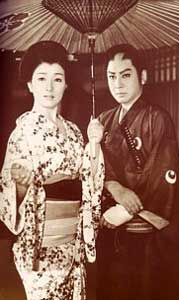 Sawada's performance in this film had been imitated ever since, as it was startlingly realistic for emotional content & scary swordplay. A screen-capture for this film is immediately above, showing Sawada, even with heavy make-up, able to show credible emotion. Sawada's performance in this film had been imitated ever since, as it was startlingly realistic for emotional content & scary swordplay. A screen-capture for this film is immediately above, showing Sawada, even with heavy make-up, able to show credible emotion.
By the hairline & the mon the character is easily recognized, whoever plays him, as in the example (with this paragraph) showing Kazuo Hasegawa in the Tsukigata Hanpeita: Hana no maki, Arashi no maki (1956), a remake by the same director of the influential 1925 original, & the first version in full color.
He was supported by an impressive all-star cast including Machiko Kyo, Ayako Wakao, Tamao Nakamura, Shintaro Katsu, & Raizo Ichikawa. Raizo most curiously sports the hairstyle usually associated only with Tsukigata.
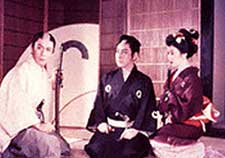 Raizo's character was Tatsuma Hayase. He is shown in the three stills. Plus he & Kazuo are shown standing back-to-back in a blue lobbycard reproduced at the top of the page, Kazuo's moon-crest showing clearly on his sleve though Raizo has the hairstyle. Raizo's character was Tatsuma Hayase. He is shown in the three stills. Plus he & Kazuo are shown standing back-to-back in a blue lobbycard reproduced at the top of the page, Kazuo's moon-crest showing clearly on his sleve though Raizo has the hairstyle.
Several versions do not survive either in whole or in part. One was by the great Daisuke Ito (Hanpeita Tsukigata, Nikkatsu, 1933), starring superstar Denjiro Okochi.
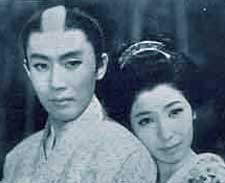 Though it appears that this film doesn't survive, from surviving scenarios & stills, we may be safe surmising a resemblance to the 1961 remake, since the version starring Hashizo Okawa was based on Daisuke Ito's script. Though it appears that this film doesn't survive, from surviving scenarios & stills, we may be safe surmising a resemblance to the 1961 remake, since the version starring Hashizo Okawa was based on Daisuke Ito's script.
Other versions have included as follows: Directed by Juko Takahashi (Hanpeita Tsukigata, Nikkatsu, 1926) starring Goro Kawabe.
Directed by Hiroshi Innami (Hanpeita Tsukigata, Yamaguchi Toshio, 1928) starring Toshio Yamaguchi.
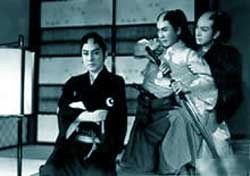 Directed by Yoshiro Edamasa (Hanpeita Tsukigata, Tao, 1929) starring Minoru Kusama. Directed by Yoshiro Edamasa (Hanpeita Tsukigata, Tao, 1929) starring Minoru Kusama.
Directed by Taizo Fuyushima (Hanpeita Tsukigata, Shochiku, 1929) starring Chojiro Hayashi.
The following decade produced further examples: By Shuntaro Okayama (Hanpeita Tsukigata, Bantsuma, 1931) starring the biggest star of the silent era, Tsumasburo Bando.
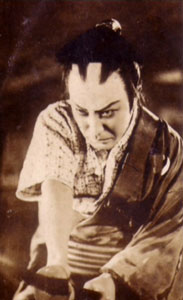 Affectionately known to his public as "Bantsuma," Tsumasaburo Bando's realism at swordplay was nearly unmatched in his day, & very unfortunate this version doesn't survive. The sepia still of Bantsuma closest to this paragraph shows him in this very role. Affectionately known to his public as "Bantsuma," Tsumasaburo Bando's realism at swordplay was nearly unmatched in his day, & very unfortunate this version doesn't survive. The sepia still of Bantsuma closest to this paragraph shows him in this very role.
Still others lost to us were by Minoru Ishiyama (Hanpeita Tsukigata, Momonosuke, 1933). By Kumahiko Nishina (Hanpeita Tsukigata, Kyokuto, 1935) starring Mitsuaburo Ramon.
And by Matsuo Yamamoto (Hanpeita Tsukigata, Arakan, 1935) starring Kanjuro Arashi.
The popular character is very thinly based on a combination of history's Ryoma Sakamoto & his childhood friend Takechi Hanpeita aka Takechi Zuizan (1829-1865), a master swordsman of Tosa whose interest in western culture is believed to have sparked Ryoma's later political thinking.
History's Hanpeita/Zuizan founded the Royalist Kinnoto-gumi, a political party in which Ryoma was enrolled, & was arrested by the Tokugawa regime & forced to commit seppuku.
Fictionally, however, Ryoma's politics & tragic assassination provide the heart of Tsukigata's character. The specific character traits of the filmic Tsukigata Hanpeita are largely fictional. He's often shown as devil-may-care, a drunk & pleasure district denizen, which would not describe either Ryoma or Zuizan, though some versions show Tsukigata's angst which might better suit Ryoma, & of course his sentiment that Japan should emerge from feudalism as an egalitarian society, right out of Ryoma's actual biography.
Cinematic treatments of the original Takechi are encountered (for key examples) in Izo (2004) played by Ryosuke Miki, in Tenchu! (Hitokiri, 1969) played by Tatsuya Nakadai, & Will to Conquer (Tenkan no abarembo, 1970) played by Isao Kimura. Takechi tends to be portrayed as a completely ruthless leader of Tosa royalists, not the pleasant figure embodied by Tsukigata.
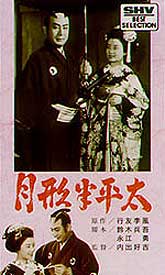 The name Tsukigata, alluding to the Moon, was probably borrowed from a third historical figure, Tsukigata Senzo, persecuted by the Tokugawa regime & forced to flee Choshu immediately before the Meiji Restoration. The name Tsukigata, alluding to the Moon, was probably borrowed from a third historical figure, Tsukigata Senzo, persecuted by the Tokugawa regime & forced to flee Choshu immediately before the Meiji Restoration.
The number of films with different actors who played him has not been exhausted by these citations.
U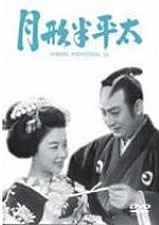 taemon Ichikawa best remembered as "the bored hatamoto" or "crescent-scarred hatamoto" series starred in Tsukigata Hanpeita no uta (Shochiku, 1952) with Hibari Misora co-starring, under the direction of Kokichi Uchida (1911-1994). taemon Ichikawa best remembered as "the bored hatamoto" or "crescent-scarred hatamoto" series starred in Tsukigata Hanpeita no uta (Shochiku, 1952) with Hibari Misora co-starring, under the direction of Kokichi Uchida (1911-1994).
The last illustration files on this page is an old video box for this version, & a more recent limited edition dvd box.
Hashizo alas brought nothing particularly new to his 1961 remake. He never quite harmonizes the "singing samurai" lightheartedness of the opening scene with the seriousness of Tsukigata's violence & ultimate tragedy, though the point is supposed to be that Tsuki hugely loved life, increasing the injustice that he didn't live long enough to see his dream come true, of Japan's belated emergence from medievalism.
copyright © by Paghat the Ratgirl
|

